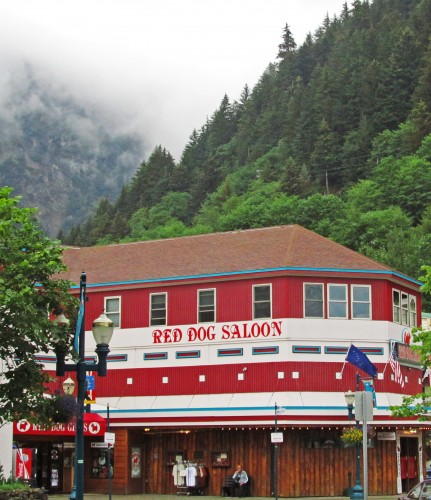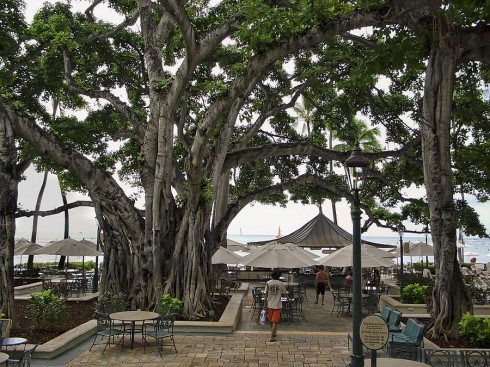A VETERAN BOOKMAN’S ROAD TRIP CONFESSIONS
Red Dog Saloon, Juneau, Alaska
By Bob Vickrey
When I walked through the swinging doors of the Red Dog Saloon, everyone in the dimly lit bar seemed to stop what they were doing to check out the stranger who had entered their private domain.
I found an unoccupied seat at the crowded bar and ordered a Kodiak Ale on tap. The bartender studied me before asking where I was from. Back then, the citizens of Juneau could easily recognize a stranger in town. This was in an era when Juneau was still a relatively isolated place, and long before the Princess Cruise ship invasion brought thousands of international tourists to its shores.
As I took a sip of the cold brew, the middle-aged bartender set down another full mug in front of me and said it had been taken care of by the dark-haired woman at the end of the bar. I acknowledged her complimentary drink with a casual wave. Before I could get the glass to my mouth, he put down a third beer while nodding toward an elderly woman at the opposite end of the bar who appeared to be waving her walking cane in my direction. He leaned over to me and whispered, “Hey pal, don’t let all this go to your head, because women here don’t see many new men coming through town.” As I scanned the room, I saw no evidence the place had a back entrance which might provide a swift exit.
The daily life and attendant perils of the traveling salesman might not have been everyone’s cup of tea (or beer, in this case), and the lifestyle had been known to have taken a dramatic toll on some of those who lived it.
I was one who chose that particular mission, and surprisingly, lived to tell about it. Some personalities are perhaps better suited for the “Willy Loman” lifestyle than others. I was a salesman for an East Coast publishing firm for almost four decades and spent a good portion of each year on the road living in hotels. The job description might sound like a “life sentence” to some, while that very same existence held great appeal for determined road warriors like me. Back then, the traveling lifestyle and the constantly changing surroundings shielded me from the sheer boredom of the daily office grind that I had envisioned it would be.
While visiting bookstores throughout my territory and presenting books from my company’s seasonal catalog required some diligent preparation and homework, the actual appointment with receptive booksellers was often remarkably stress-free. By their very nature, booksellers were welcoming to those who shared the same profession. We all knew that bookselling was a rather eccentric business, and certainly one lacking in the true definition of an industry. Books were the binding component in our nascent business relationship.
Early in my career, I spent an inordinate amount of time in cities named Lubbock, Midland, and Odessa, and during that period, “Tuesday, this must be Amarillo” became my steadfast refrain. But whatever that particular West Texas town might have lacked in glamour and beauty, it more than made up for in my absolute amusement at the endlessly flat landscape. Author Larry McMurtry once said about the region in which he had been raised, “The only thing that breaks the wind in West Texas is the barbed-wire fences.”
I liked the people there. Even though they were slightly distrustful of outsiders, West Texans were nevertheless unfailingly hospitable to the weary traveler.
Several years later, my company offered a job based in Southern California, which entailed covering several Southwestern states, including Nevada, Arizona, and New Mexico. And just for a little spice, they threw in Alaska and Hawaii. That addition made this decision an instant no-brainer, and within several weeks of my move, I found myself comfortably entrenched in the Southern California lifestyle.
I wasted no time in making arrangements for the first trip to Alaska and Hawaii. At that time, Western Airlines offered a triangular fare between Los Angeles, Anchorage, and Honolulu, with one small caveat. The flight departed and arrived only once a week—on Wednesday evenings. Translation: Don’t miss your flight.
I was excited about visiting Anchorage because I had friends there whom I had worked with in Texas when I had first entered the book business. They owned two bookstores in town, so our reunion would consist of a pleasant mix of business and pleasure.
Only days later, I found myself wading ankle-deep in a shallow stream running beneath a roadway bridge on the outskirts of Anchorage with instructions from my friends to “catch our dinner for the evening.” I was equipped with only a plastic bag as I chased a three-pound salmon upstream while my friends, Dave and Joyce, watched and laughed from atop the bridge. After a number of failed attempts to capture the slippery creature, and several incriminating photos later (that undoubtedly documented my futility), I finally managed to bag our dinner.
Within hours of arrival at their home, Dave had already placed several sizzling salmon fillets on the backyard grill. I sensed this might just be a dining experience for the ages, and my speculation turned out to be correct. Later that same evening, I assured my hosts that this was an even better meal than the one I had enjoyed during my last visit to Red Lobster in Lubbock. If this particular day’s adventure represented a typical road trip in my new territory, I decided this had indeed been a worthwhile career move.
After my visits to Anchorage and Fairbanks—plus my narrow escape from Juneau’s Red Dog Saloon—I was off to Honolulu. This trip represented a traveler’s nightmare when packing for the winter season. It required the world’s heaviest overcoat for Fairbanks’ sub-zero nights, plus swimming trunks and flip-flops for Waikiki. I was always curious what airport security agents thought as they rummaged through the contents of my bags.
The Moana Surfrider Hotel, Honolulu, Hawai
When I arrived in Honolulu, I was driven straight to the Moana Hotel, the historic wooden palace located on the scenic shores of Waikiki Beach. I had already made a command decision to stay out of dark bars on this leg of the journey. I estimated I had a couple of hours of beach time left in the afternoon, and after a long search through my baggage, I eventually found my swim trunks stuffed inside the sleeve of my Fairbanks’ overcoat. It seems the Alaskan TSA agents decided to send me on my own personal treasure hunt. Jealousy, perhaps?
Actually, I had plenty of work ahead that evening in my hotel room preparing for the following day’s meeting with the buyer from the Honolulu Bookshop chain, which had several stores scattered throughout the islands. There were several prominent independent bookshops on Oahu, Maui, and the Big Island of Hawaii, but it was Honolulu Books that underwrote much of the cost of each season’s trips.
Our company’s fall catalog featured several promising best-seller candidates like “Second Generation,” by Howard Fast, which was the sequel to his earlier runaway success, “The Immigrants.” Also, that season, we were releasing Arthur M. Schlesinger’s long-awaited biography, “Robert Kennedy and his Times,” as well as “Hollywood’s Children,” written by my longtime friend and former silent film star, Diana Serra Cary. I entertained selfish motives concerning each book’s potential success. If they eventually became big best-sellers, I might possibly be assured of a return trip to the Islands later that same year.
The day after my appointment with Honolulu Books, I took an early morning flight to the Big Island of Hawaii, and was met at the Hilo Airport by my client who owned the largest wholesaling operation there. John gave me a tour of the island in his open-air jeep as he pointed out spectacular waterfalls on the way to witness the island’s “active” volcano at Kilauea. He whisked me off to lunch at the Hilo Country Club, and after a whirlwind day of business and sight-seeing, dropped me back at the airport for my return flight to Honolulu. My head was still spinning slightly as I drove back to my Waikiki hotel.
I had managed to secure a corner room at the Moana with one window facing Diamond Head and the adjacent one featuring a view of the shimmering emerald-green waters of the Pacific. As I stood gazing down upon the legendary Banyan Tree Bar in the outdoor courtyard, I remembered it had long been rumored this was the pristine spot where Robert Louis Stevenson had sought inspiration and penned some of his very best prose in the 1880s.
Underneath the Banyan Tree in the Moana Courtyard
The following day after my bookstore appointments, I returned to the hotel for a late-afternoon respite in the courtyard underneath the enormous Banyan tree. It occurred to me that as Stevenson had once stared out at the breaking Pacific surf in this astonishingly beautiful setting while sipping his drink and writing his novel, he must have decided right then and there that he had surely discovered his Nirvana.
That evening under the very same Banyan tree, now almost a century later, it dawned on me that Mr. Stevenson and I had likely shared the same epiphany regarding our daily routines. I think he had definitely stumbled upon something here. Perhaps in the foreseeable future, it might be in my company’s best interest if I diligently investigated bookselling prospects on these islands much more thoroughly and left no stone unturned. I would need to inform my employer that this extensive search might force me to spend considerably more time here. I was quite sure they would understand.
Bob Vickrey’s columns appear in several Southwestern newspapers including the Houston Chronicle and the Ft. Worth Star-Telegram. He is a member of the Board of Contributors for the Waco Tribune-Herald. He lives in Pacific Palisades, California.
Comments
Leave a Reply
You must be logged in to post a comment.






